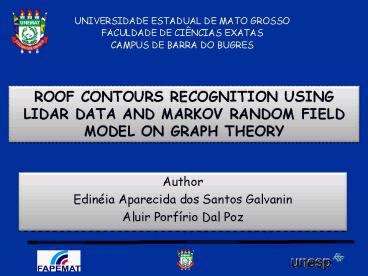Vender idia ou produto PowerPoint PPT Presentation
1 / 19
Title: Vender idia ou produto
1
(No Transcript)
2
Motivation Methodology Results
Conclusion
LiDAR technology has become common in recent
years, allowing rapid and efficient acquisition
of the Digital Elevation Models
Object segmentation in urban areas, due to scene
complexity, requires the development of specific
methods that integrate the neighborhood
information and the domain knowledge of
characteristics of the interest objects
3
Introduction Methodology
Results Conclusion
4
Introduction Methodology
Results Conclusion
Object extraction and generation of Digital
Terrain Model
5
Introduction Methodology Results
Conclusion
This paper proposes a methodology for automatic
extraction of building roof contours using a
graph-based MRF.
Main advantage is to provide a general and
natural model for the interaction among spatially
related random variables in the image.
6
Introduction Methodology Results
Conclusion
The proposed methodology comprises the following
preprocessing steps
High regions
roof properties definition
Energy function
Minimization
yes
Stability
Roof contours
not
7
Introduction Methodology
Results Conclusion
Recursive splitting region segmentation, region
merging , vectorization and polygonization
8
Introduction Methodology
Results Conclusion
High regions
roof properties definition
Energy function
Minimization
yes
Stability
Roof contours
not
9
Introduction Methodology
Results Conclusion
Using the available contours, a region adjacency
graph (RAG) is constructed
10
Introduction Methodology
Results Conclusion
The construction of the energy function depends
on a prior knowledge of the properties of the
object roof.
The features for the first order clique used is
the area and rectangularity.
The area feature allows small object in relation
to roofs, can be discarded.
11
Introduction Methodology
Results Conclusion
The third attribute allows the verification of
parallelism or perpendicularity between objects
12
Introduction Methodology
Results Conclusion
High regions
roof properties definition
Energy function
Minimization
yes
Stability
Roof contours
not
13
Introduction Methodology
Results Conclusion
weights that gives relative importance to each
term of energy
rectangularity parameter of the object .
the area of object
angle between the main axes of objects
14
Introduction Methodology
Results Conclusion
High regions
roof properties definition
Energy function
Minimization
yes
Stability
Roof contours
not
15
Introduction Methodology
Results Conclusion
three-dimensional visualization of the DEM used
in the test
16
Introduction Methodology
Results Conclusion
The extracted polygons are overlaid in red on the
intensity image. This figure also shows the
reference polygons (in blue) and a false negative
(in green).
17
Introduction Methodology
Results Conclusion
The choice of test area took into account the
complexity of the configurations of objects in
the scene
In general, a good indication of robustness of
the proposed methodology was the lack of false
positives and the verification of few false
negatives.
The completeness parameters showed that the
extracted polygons generally have high
superposition with their reference polygons.
18
REFERENCES Dubes, R. C., Jain, A. K., 1989.
Random Field Models in Image Analysis. Journal of
applied Statistics, v. 16, n. 2, pp. 131164.
Haala, N., Brenner, C., 1999. Extraction of
buildings and trees in urban environments. ISPRS
Journal of Photogrammetry e Remote Sensing, v.54,
pp.130-137. Jain, R. Kasturi, R Schunck, B.
G., 1995. Machine vision. MIT Press and
McGraw-Hill, Inc New York. Kinderman, R., Snell,
J. L. 1980. Markov Random Fields and their
applications. Providence, R.I American
Mathematical Society. Kirkpatrick, S., Gelatt,
C. D., Vecchi, M. P. 1983. Optimization by
Simulated Annealing, Science, pp.
671680. Kopparapu, S. K., Desai, U. B. 2001.
Bayesian approach to image interpretation. 127p.
19
THANKS FOR ATTENTION

